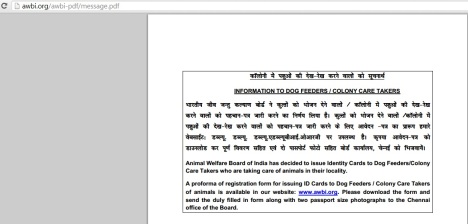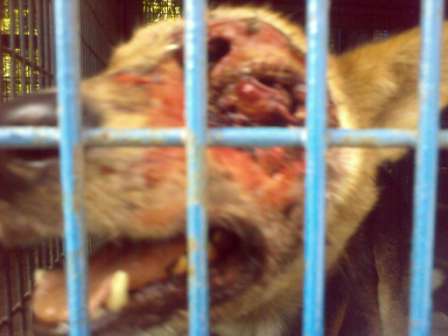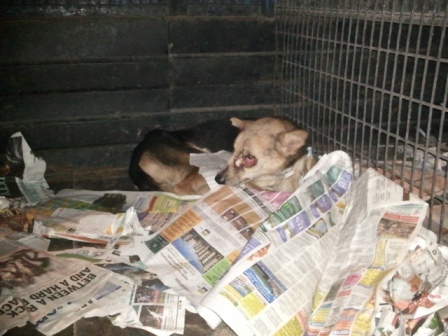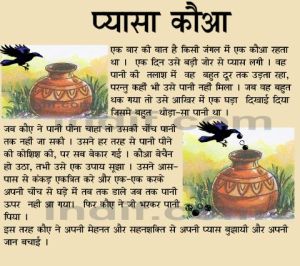By Dr. Ilona Otter, DVM, Clinical Director of WVS ITC (Worldwide Veterinary Service India Training Center)
Dr. Ilona is also the Honorary Veterinary Consultant of Niligiri based Animal Welfare Organisation called IPAN- India Project on Animals and Nature.
In the article below Dr.Ilona pens down a brief summary about rabies and stray dogs in India to answer some questions and matters that are brought up in various discussion forums. Dr. Ilona hopes that this information will help those who are struggling with the facts and myths prevailing around the topic.
1. Introduction
Rabies kills more than 55 000 people in the world every year (WHO website). India counts at least for approximately 20000 of the number of human deaths (WHO SEA report 2009). These are very sad statistics of a disease that is 100% preventable by vaccination.
The main obstacle in preventing canine and human rabies in India is the lack of sustainable centralized effort and the fact that rabies by law is not a notifiable disease.
Canine rabies control is also often only associated with voluntary animal welfare organizations or groups even though it is a matter of public health and should therefore receive high priority in the public veterinary services and also in human health care sector, being the most cost-effective way to reduce human rabies cases.
The AWOs role in rabies control is, however, very much needed. Especially because often they only have the necessary infrastructure and staff to carry out mass rabies vaccinations on the field and to educate public of the importance of regular rabies vaccinations for their dogs. However, a greater understanding among AWOS of the need of effective canine and human rabies control by massive and sustainable mass vaccination campaigns for the sake of animal welfare is required. The cruelty and ignorance that many stray dogs face has often its roots in the fear that people have for rabies. We can’t expect the majority of general public to love dogs as long as there is such a high risk for rabies.
2. Options for prevention of human rabies
Rabies causes a horrible death and once the symptoms start there is no cure. However, there are three ways to prevent rabies in humans; by preventing the transmission of the rabies virus within the host species and by treating all people that have been bitten by dogs of unknown vaccination status or by vaccinating people with pre-exposure rabies vaccines. Prevention of canine rabies by dog vaccination and the post-exposure treatment are discussed further in this text. Public education is a crucial component of both approaches.
a. Preventing canine rabies:
Modern vaccines to prevent rabies are all derived from tissue-cultures. The sheep-brain culture method is no longer in use. Reputed international medical companies (e.g. Pfizer and Intervet) as well as Indian immunologicals produces reliable rabies vaccines that provide protective antibody titres when stored and administered properly. One dose of rabies vaccine for dogs in India costs Rs. 25. The manufacturers recommend a booster vaccination every 1-3 years depending on the rabies situation in the area. To achieve herd immunity and sufficient vaccination coverage to prevent transmission of rabies virus, 70% of the dog population has to be vaccinated. It has been shown that even in developing countries where dogs commonly roam free, most of them are accessible to parenteral vaccinations when vaccination camps are planned and arranged properly (Kaare et al., 2007). Oral rabies vaccine baits can be used in areas where it is difficult to achieve an adequate vaccination coverage by injectable vaccines only, especially when the wildlife reservoir is important (Matouch et al., 2007). Oral rabies vaccines have been used for decades in many European countries to prevent rabies transmission from wild carnivores like foxes and raccoon dogs.
b. Treatment of humans by post-exposure vaccination
According to some estimates, approximately 500 000 people in India receive every year the post-exposure vaccination treatment that consists of 5 vaccine doses and costs Rs. 1500 (excluding the cost of general wound care, hospitalization and time away from work). According to M.K.Sudarshan’s survey (2007) the full cost of post-exposure treatment of humans that have been bitten in India is $25million.
Unfortunately, many indigenous treatments still prevail among rural communities and not even everyone knows to wash their wounds after being bitten. Poverty, lack of understanding of the need to start the vaccinations on the very same day and also lack of availability in the rabies anti-serum which is needed in the treatment of the most severe bites all contribute to the sad statistics of human rabies in India (Sudarshan, M.K., 2007).
While it is common to hear the parties that are against dogs to defend their standpoint by saying that when people suffer money should not be spent on dogs, it is worth noting that at least 30 million dogs in India could be vaccinated against rabies every year with the amount of money that is spent on the post-exposure vaccinations of humans. The estimated stray dog population in India is 8-20 million. The fact that major savings in the human medical sector are likely to occur when mass vaccinations of dogs start effectively taking place has been noted by several published reports (Cleaveland, et al., 2003; Lembo et al., 2010).
c. Experiences from the world
The often quoted claim that most dogs in Asia or Africa are stray dogs and not accessible to vaccination has been proven wrong as recently reviewed by Lembo. WHO-commisioned study of Tunisia, Sri Lanka and Ecuador concluded that “dogs which are not catchable by at least one person are rare and represent generally less than 15% of the dog population” (WHO, 1988). The same figure in India is not known but likely to be much higher. However, trained dog-catchers are able to catch dogs on the roads by catching nets and in more difficult terrains trap-cages can be used for catching.
Central-point vaccination programs that are announced before hand or door-to door vaccination teams have been able to reach to 80% of the dogs with a low as low as US$2/dog cost, as documented by several studies (Kaare et al., in 2007; Cleaveland et. al in 2003). In Nepal, 86-97% of dogs were accessible to parenteral (injectable) vaccination (Bogel, 1990).
In Mexico, human rabies cases declined to zero within ten years since mass vaccination of dogs started (Lucas et al., 2008).
In India, Jaipur is an example of a city where rabies control through mass vaccination and neutering of dogs has resulted in eradication of human rabies (Reece and Chawla, 2006).
In developed countries the low numbers of rabies cases are not the result of mass killing of dogs nor of spending millions in public medical care and post-exposure vaccinations. The secret for better than India rabies situations lies in the fact that rabies is a notifiable disease by law; dog vaccination to cover most of the dog population is a well-established practice, border control requires traveling dogs to be regularly vaccinated with a certificate of sufficient rabies antibody titre in the blood (Regulation (EC) No. 998/2003) , wild rabies from foxes and raccoon dogs is controlled by distributing oral vaccine baits in the forests and the habitat where garbage is not let in the open doesn’t support reproducing stray dog population.
3. What if ? – Elimination of dogs?
Elimination of absolutely all dogs, both owned and ownerless, both pedigree breed and mixed breed or country dogs, in India by killing them or banning them or by taking them to shelters is not possible. As long as there are enough susceptible individuals of the host species, virus transmission will continue. As long as there are free-roaming dogs somewhere, they will take the place of those that were removed.
a. Ecology and habitat matters
The poor garbage disposal system all over the country and the presence of chicken stalls and small butcher shops in and around the city markets and in the suburban surroundings means that there is edible waste for animals to feed and live on. If absolutely all dogs are eliminated by any method, it is likely that their place in the feast is taken over by another species, e.g. rats, monkeys, cats or wild pigs. All of them will carry their own risks for public health not to mention the harm that is caused if all that waste is just let to rotten below our windows.
Thieves are likely to become braver if a community or a colony does not have any watchdogs to guard the people and their property.
A zero-garbage city or even better the Zero-Garbage-India, would be an excellent benefit for the citizens in many ways, including the fact that stray/feral animal numbers would go dramatically down if there was nothing for them to eat on the roads and backyards. This is a challenge that the solid waste management department of every district in India should be made to take really seriously, by centralized incentive/penalty system if so required for compliance.
An observational report from the Wellington Cantonment, Coonoor, Tamil Nadu, by the Health Superintendant in 2010, states that since they started door-to-door collection of garbage in the civilian area of the Cantonment the dog population that used be very big has drastically declined.
b. Stray dogs in developed countries
Common policy in many western / developed countries is to take in all stray animals in shelters where they are neutered, vaccinated and then rehomed. Unlike in India, stray dogs in those countries are often actually strays, meaning they are run-away pets or abandoned pet dogs that would not survive on the roads on their own because there are no open garbage bins nor butcher shop backyards. As the numbers are limited, those animals can be taken in to rehoming shelters where they are neutered, vaccinated and rehomed to responsible owners.
Streets without stray dog problem in Singapore, Stockholm, San Francisco or Sydney are not the result of indiscriminate killing of thousands or millions of dogs but a fact that the problem has never risen to the extent because of different sanitary and ecological conditions, dog licensing programs, public education for responsible ownership and well-developed rehoming shelters.
4. Animal Birth Control program (ABC-program)
The objective of the ABC program is to reduce the population of dogs in a given area. To be effective in that, the work has to be intensive – 70% of the dogs should be neutered during one breeding cycle, that is during six months. This is possible but requires strategic planning and an experienced veterinary surgeon with trained assistants who can perform the operations without complications.
Dogs are territorial animals and therefore a small group of sterilized and vaccinated dogs protect and defend the community they live in from any outside dogs wandering in search for mate or new territory.
a. Role of ABC in rabies control
Having a dog neutered doesn’t prevent it from getting infected with rabies. Usually all the ABC programs include rabies vaccination to the operated dogs. However, the main benefit of the ABC program in rabies control is in the overall reduction of population growth. By doing ABC we aim to stabilize the dog population to a level where sufficient rabies vaccination coverage can be maintained by annual vaccination days. Success of ABC program in controlling the stray dog population has been demonstrated scientifically in India (Totton et al, 2010; Reece and Chawla, 2006).
However, whenever the pressure to prevent rabies is very bad, an effective mass vaccination campaign at first is the preferred option, followed immediately by intensive animal birth control program to maintain the vaccination coverage sufficient.
b. Population dynamics
Whenever and wherever ABC-program is judged not to work it is either that it has not even been implemented on that particular area or that it has not been implemented effectively enough. If only 200 dogs are operated from a population of 10 000 with great deal of media attention as the program starts, the public is likely to start questioning the sensibility of the program when they observe no results after a year. However, if two full-time teams are employed to work for six months they can achieve the required level of 7000-8000 neutered and vaccinated dogs and the impact is clear. Such a high volume campaign should easily receive media attention and have an impact in the public awareness meaning that people are likely to start bringing their pet dogs also for vaccination & for neutering, further improving the success of the program as less unwanted pet dog puppies will end up on the roads.
About the Worldwide Veterinary Service India Training Center
WVS India training center located in Ooty, Nilgiris, Tamil Nadu, is going to provide training for animal charities in arranging effective rabies control campaigns. The program consists of three modules that are to be attended by different people of the charity; managers, veterinarians and assistants/dog-catchers. While we initially target charities as participants, the courses will be open also for municipalities and corporations who want to train their staff to significantly reduce rabies in their areas for the benefit of the public.
The training center, known as the ITC, has an operation theatre for five surgeons to operate at a time, custom-made kennels to hold the dogs and several classrooms as well as dining and accommodation for 30 people.
Visiting foreign volunteer teachers as well as the experienced WVS ITC staff conduct the courses and all participating charities will be supported by advice, volunteers and materials to carry on the rabies control work in their areas after the courses. Participation is free of cost but a participating charity/municipality/corporation has to commit in implementing the rabies campaign as planned for that specific area during the course immediately after the training.
The opening ceremony of ITC is on the 28th September, the world rabies day. The center will be inaugurated by the Chairman of Animal Welfare Board of India, Dr. R.M. Kharb. While personal invitations will be send to the WVS associated charities and other key people in this field in India, we warmly welcome all interested people to join us for the ceremony.
More information at
www.wvs.org.uk
www.rabiesblueprint.com
www.worldrabiesday.org
References
Bogel K., Joshi DD (1990) Accessibility of dog populations for rabies control in Kathmandu valley, Nepal. Bull World Health Organization 68:611-617
Cleaveland, S., Kaare, M., Tiringa, P., Mlengeya, T., Barrat, J. (2003) A dog rabies vaccination campaign in rural Africa: impact on the incidence of dog rabies and human dog-bite injuries, Vaccine 21; 1965-1973
Lembo T, Hampson K, Kaare MT, Ernest E, Knobel D, et al. (2010) The Feasibility of Canine Rabies Elimination in Africa: Dispelling Doubts with Data. PLoS
Negl Trop Dis 4(2): e626. doi:10.1371/journal.pntd.0000626
Lucas CH, Pino FV, Baer G, Morales PK, Cedillo VG, Blanco MA, Avila MH (2008) Rabies control in Mexico, Dev Biol (Basel).;131:167-75.
Matouch O, Vitasek J, Semerad Z, Malena M.(2007) Rabies-free status of the Czech Republic after 15 years of oral vaccination. Rev Sci Tech. Dec;26(3):577-84.
Regulation, 2003 Regulation (EC) No. 998/2003 of the European Parliament and of the Council of 26 May 2003 on the animal health requirements applicable to the non-commercial movement of pet animals and amending Council Directive 92/65/EEC.
Sudarshan MK. Assessing burden of rabies in India. WHO sponsored national multi-centric rabies survey ( 2004). Assoc Prev Control Rabies India J 2004;6:44-5.
Reece, J.F., and Chawla S.K.(2006) Control of rabies in Jaipur, India, by the sterilisation and vaccination of neighbourhood dogs. VetRec. 16: 159 (12):379-83
Totton, S.C., et al., Stray dog population demographics in Jodhpur, India following a population control/rabies vaccination program. PREVET (2010), doi:10.1016/j.prevetmed.2010.07.009
WHO report; Rabies in the South-East Asia region, 2009
WHO website www.who.org accessed in August 2010
WHO (1988) Report of a WHO consultation on a dog ecology studies related to rabies control. Geneva: Word Health Organization (WHO/Rab.Res/88.25)


























![its my place 5[1]](https://jaagrutiindia.files.wordpress.com/2010/08/its-my-place-51.jpg?w=660)













